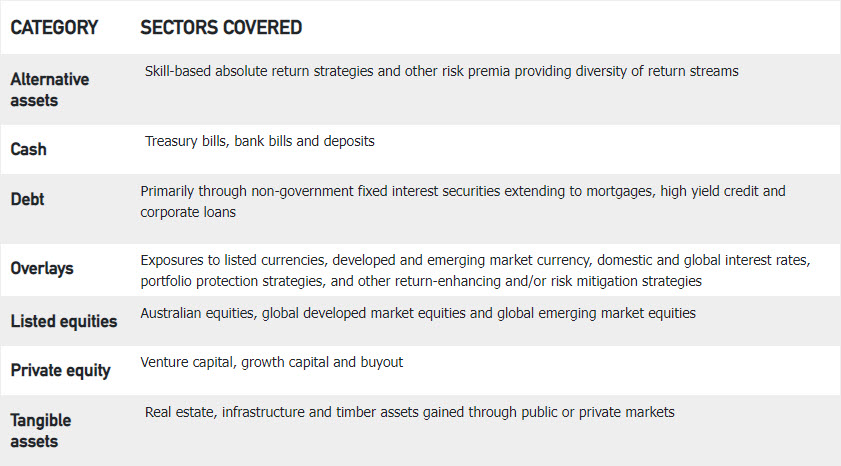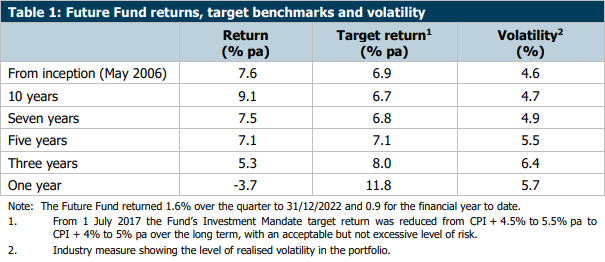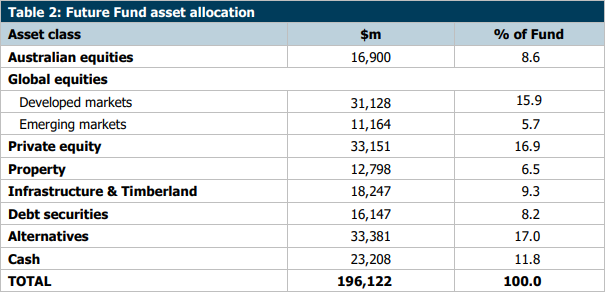Can you replicate the Future Fund via the ASX?
The Future Fund (FF) is Australia’s sovereign wealth fund, established in 2006.
The goal of the Fund is to strengthen the Australian Government’s long-term financial position by making provisions for unfunded superannuation and other liabilities.
This is an important function. One need only look to the unfunded liabilities of the US government to understand how big a problem this can become.
The Future Fund currently looks after about $210 billion in investments and has the mandate to target a benchmark return of at least the Consumer Price Index + 4-5% per annum over the long term, while taking an acceptable but not excessive level of risk.
What has the performance been and why would you want to replicate it?
The performance of the Future Fund has been excellent, amid what has been a volatile period for markets. Since 2006 we’ve seen the GFC, the euro debt crisis, and a pandemic, not to mention a host of other significant events. From the Fund’s most recent update:
Over the past decade the Future Fund has delivered an average annual return of 9.1% against a target of 6.7%. Since 2006, with an initial contribution of $60.5bn, the Fund has grown to its present $196.1bn at the end of December, without any injection of capital or any further contribution.
Since inception, the numbers are a little less appealing, with an annual return of 7.6% - although this is still ahead of the 6.9% target return over that period.
For the calendar year 2022 the S&P ASX 200 fell 5.5% and the S&P 500 dropped 13.6%. Against this, the Future Fund’s defensive posture limited falls and delivered an outcome of -3.7%.
This last stat is important, and reflective of the Fund’s objectives. The Fund portfolio is “positioned towards the middle of the range of risk settings”, according to CEO Dr. Raphael Arndt.
Whilst the Fund is focused on its performance objective, it also has a keen focus on risk. It reports volatility next to its performance returns, as can be seen in the table below;
The message is clear, the FF wants to achieve better-than-average returns but without taking on excessive amounts of risk. I expect this goal would be appealing to many Livewire readers.
As part of our Listed Series, we thought it would be an interesting exercise to see how closely you can replicate the Future Fund using exchange-traded products available to all investors.
Before diving into that exercise, however, let's set the scene. The following information was provided by the FF in their recent position paper: Death of traditional portfolio construction?
Given where the world is today institutional investors are likely to need to work harder and employ different combinations of strategies than they have in the past.
The structural tailwinds driving market returns are fading and headwinds are challenging investors’ ability to achieve their return objectives, while levels of risk and volatility are higher.
Alpha is more important than ever
Taking more traditional market risk will only have a limited impact on achieving higher real returns. In fact, it could increase the risk of large negative returns in the short-to-medium-term, with history suggesting such periods can extend across a decade.
Generating excess returns through alpha becomes ever more important but this presents challenges in the ability to identify and access those opportunities.
So, things are getting harder, traditional relationships between risk and return are changing, and investors will need to employ different combinations of strategies to generate returns.
It is also worth noting that what follows below is not a like-for-like comparison. The Future Fund has access to the largest financial institutions on the planet and the smorgasbord of investment opportunities they offer.
The list of the institutions and investment managers that the FF uses can be found here. Very few of those institutions or products they offer are available via the ASX.
But, as we’re about to discover, there are plenty of alternatives.
So, how would you do it?
For help with this herculean task, I reached out to Nathan Umapathy, sector manager at Lonsec. Umapathy did a power of work on providing options to fulfill the allocations in the FF with ASX-listed products but notes that these suggestions are merely for illustrative purposes only, rather than recommendations or endorsements. It goes without saying that this is an intellectual and educational exercise and not intended advice.
Umapathy also highlighted that in some areas, there are decisions that need to be made by the individual investor; do you choose passive or active? What style of fund do you choose within, for example, Australian equities… is it growth, income, defensive, etc?
With this in mind, Umapathy noted that the simplest way to undertake the exercise would be to select all passive investments, removing a layer of complexity. This would, however, remove your ability to pursue factors that the Future Fund has identified as areas of opportunity. For example in Australian Equities, they may have a desire to target Value over Growth rather than just buying the entire index.
The table below provides an overview of the sectors that sit underneath the broad asset class categories.

The FF doesn't provide much more information on its portfolio construction, although we did get some high-level insights in the recent position paper Death of traditional portfolio construction?
The Fund notes that different investors have different objectives, cash flows and liquidity needs, as well as widely differing beneficiaries. Investors need to carefully assess how their particular context will be impacted by a range of possible future scenarios – this is the FF’s way of saying do your own research and consider your own personal circumstances.
As a result of the more challenging environment, the Fund identified a number of portfolio implications, and the levers that they will pull to address these implications - scroll left to right on the table below for all implications.
| Portfolio implications | More alpha | More volatility | More granular |
More correlation caution |
More domestic exposures |
More defensive levers, inflation protection |
| Levers activated | More private equity |
Focus on liquidity and dynamic asset allocation |
Detailed levers for DM/EM |
Broader currency basket |
Added to Infrastructure |
Added Gold, Commodities, Tangibles, Alternatives |
Source: Death of traditional portfolio construction?
These changes can be summarised as follows and are important to keep front of mind when we work through the exercise of replicating the FF via the ASX;
- Genuine diversification
- More private equity
- Liquidity and dynamic asset allocation (active portfolio management from a macro/top-down perspective).
- More currencies, more infrastructure, more gold, commodities and alternatives
Here. We. Go.
Below are the FF allocations broken down, as well as some commentary from Umapathy for each allocation.
AUSTRALIAN EQUITY – 8.6% of the Future Fund
Active:
In this allocation, Umapathy notes that there weren't many options for Active ETFs that have Australian equity mandates. There are, however, "quite a few LICs that might be able to provide this exposure". Umapathy adds that AFI and ARG are well-established and provide Australian Equity Large Cap exposure.
Passive:
| iShares Core S&P/ASX 200 ETF | (ASX: IOZ) |
| Betashares Australia 200 ETF | (ASX: A200) |
| VanEck Australian Equal Weight ETF | (ASX: MVW) |
| Betashares FTSE RAFI Australian 200 ETF | (ASX: QOZ) |
Under passive exposure, Umapathy credits IOZ or A200 as amongst the cheapest ASX200 ETFs. He goes on to point out that there are multiple smart beta options "being MVW for an equal-weighted exposure to the Australian market (de-risking from large sector bets of the market cap weighted ETFs), or QOZ which uses a RAFI methodology and has ‘mild’ value tilt". RAFI methodology selects and weights securities by fundamental measures of company size such as sales, cash flow, dividends + buybacks, and book value.
GLOBAL EQUITY (DEVELOPED) – 15.9% of the Future Fund
Active:
There are a broad range of strategies when it comes to LICs/LITs or ETFs – "perhaps even too many to choose from", notes Umapathy - and selection here really comes down to the individual investor. Some examples include:
| WAM Global Limited | (ASX: WGB) |
| MFF Capital Investments | (ASX: MFF) |
| Pengana International Equities Limited | (ASX: PIA) |
| Antipodes Global Shares (Quoted Managed Fund) | (ASX: AGX1) |
| Barrow Hanley Global Share Fund (Managed Fund) | (ASX: GLOB) |
| Hyperion Global Growth Companies (Managed Fund) | (ASX: HYGG) |
| Munro Global Growth Fund (Hedge Fund) | (ASX: MAET) |
Passive:
| Vanguard MSCI Index International Share ETF | (ASX: VGS) |
| Vanguard MSCI Index International Share (Hedged) ETF | (ASX: VGAD) |
| iShares Core MSCI World ex-Australia ESG Leaders ETF | (ASX: IWLD) |
| iShares Core MSCI World ex-Australia ESG Leaders AUD Hedged | (ASX: IHWL) |
| VanEck MSCI International Quality ETF | (ASX: QUAL) |
| VanEck MSCI International Value ETF | (ASX: VLUE) |
| Betashares NASDAQ 100 ETF | (ASX: NDQ) |
| Global X Fang+ ETF | (ASX: FANG) |
| Betashares Global Cybersecurity ETF | (ASX: HACK) |
Umapathy adds that "for straight-up beta, VGS or VGAD (Currency Hedged) are our picks", and adds that IWLD or IHWL (Currency Hedged) are options that have an ESG tilt."
When it comes to smart beta, QUAL and VLUE provide access to quality and value strategies, whilst if growth is your focus, Umapathy notes that there are many thematic-based ETFs to choose from, "plus you have the traditionally US-tech heavy ETFs like NDQ, FANG, HACK and more".
GLOBAL EQUITY (EMERGING) – 5.7% of the Future Fund
Active:
| Betashares Martin Currie EM Fund (Managed Fund) | (ASX: EMMG) |
There are limited options in this allocation, unlike in developed markets.
Passive:
| Vanguard FTSE Emerging Markets Shares ETF | (ASX: VGE) |
| VanEck MSCI Multifactor Emerging Markets Equity ETF | (ASX: EMKT) |
For passive emerging market exposure, Umapathy highlights "VGE or EMKT for smart beta" but, like active, there are limited options.
PRIVATE EQUITY – 16.9% of the Future Fund
Active:
| Pengana Private Equity Trust | (ASX: PE1) |
| WAM Alternative Assets Limited | (ASX: WMA) |
| Duxton Water Limited | (ASX: D2O) |
Once again there are limited options in private equity, but Umapathy identifies "LICs PE1, WMA, or D20" as potential solutions, whilst GPEQ is the only passive option on the ASX.
Passive:
| VanEck Global Listed Private Equity ETF | (ASX: GPEQ) |
PROPERTY – 6.5% of the Future Fund
Australian Property:
| Betashares Martin Currie Real Income Fund (Managed Fund) | (ASX: RINC) |
| Vanguard Australian Property Securities Index ETF | (ASX: VAP) |
For active Australian property exposure, Umapathy notes that "RINC is the only active ETF available, whilst VAP is passive and is our pick here".
Global Property:
| Resolution Capital Global Property Security (Managed Fund) | (ASX: RCAP) |
| VanEck FTSE International Property (Hedged) ETF | (ASX: REIT) |
| SPDR Dow Jones Global Real Estate ESG Fund | (ASX: DJRE) |
As for global property, RCAP (Currency Hedged) is put forward as "one of the more popular GREIT Active ETFs on the market".
There are only two other options for passive – REIT (Currency Hedged) or DJRE.
INFRASTRUCTURE – 9.3% of the Future Fund
| Argo Global Listed Infrastructure Limited | (ASX: ALI) |
| Vanguard Global Infrastructure Index ETF | (ASX: VBLD) |
| VanEck FTSE Global Infrastructure (Hedged) ETF | (ASX: IFRA) |
ALI is an active Global Infrastructure LIC. Passive options are VBLD and IFRA.
DEBT SECURITIES – 8.2% of the Future Fund
| iShares Core Composite Bond ETF | (ASX: IAF) |
| Vanguard International Fixed Interest Index (Hedged) ETF | (ASX: VIF) |
Umapathy's picks in the debt space are simple passive ETFs: "IAF for Australian Fixed Interest and VIF for Global Fixed Interest." Umapathy also points out that there are a lot of Fixed Income LITs and active ETFs that are listed on CBOE.
ALTERNATIVES – 17% of the Future Fund
Note that this is an area that the FF has been targeting for increased investment - more currencies, more infrastructure, more gold, commodities and alternatives
Active:
| L1 Capital Long Short Fund Limited | (ASX: LSF) |
| VGI Partners Global Investments Limited | (ASX: VG1) |
| Regal Investment Fund | (ASX: RF1) |
There are a few LICs all with very different strategies that are considered alternatives. "One could look at LSF, VG1 or RF1", notes Umapathy - although he doesn't believe that any of these strategies are similar to what Future Fund disclosed on their alternative bucket.
Passive:
| Global X Physical Gold | (ASX: GOLD) |
| Global X Physical Silver | (ASX: ETPMAG) |
| Betashares Crude Oil Index ETF Currency Hedged (Synthetic) | (ASX: OOO) |
| Betashares US Dollar ETF | (ASX: USD) |
| Betashares Australian Equities Bear (Hedge Fund) | (ASX: BEAR) |
All of the options in this space are commodity-based ETFs (metals, oil, currency) – like GOLD, ETPMAG, OOO, and USD. Alternatively, you can also hold tactical short ETFs (Betashares Bear Funds).
CASH – 11.8% of the Future Fund
| Betashares Australian High Interest Cash ETF | (ASX: AAA) |
| iShares Core Cash ETF | (ASX: BILL) |
| iShares Enhanced Cash ETF | (ASX: ISEC) |
There is only one active option in AAA. For passive options, you have BILL or ISEC.
An amazing (free) resource for conducting further research on ETFs
In undertaking this exercise, a few things have become clear(er).
Firstly, the performance of the Future Fund warrants close attention, and its investment approach, focusing on genuine diversification, is developing an enviable track record.
If it wasn’t already obvious, the world around us has changed, and we are all going to have to work a little harder than before. As the FF puts it, we’re also going to have to “employ different combinations of strategies than [we] have in the past.”
It is a good thing then, that never before have investors had so much choice when it comes to constructing a portfolio via the ASX. And whilst too much choice can often be daunting, it is incumbent upon all serious investors to avail themselves of the opportunities and to determine whether they are suitable in helping to achieve one’s goals.
The Australian ETF Directory on Market Index does an amazing job of breaking down the universe of ETFs. You can explore hundreds of ETFs broken down by region, asset class, sector and style for free. Click here to check it out.
*Special thanks again to Nathan Umapathy from Lonsec, for the power of work he did in pulling this together.
4 topics




